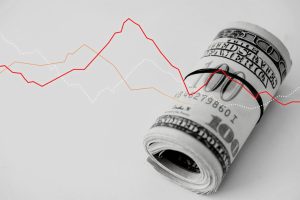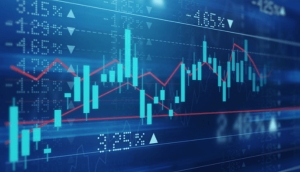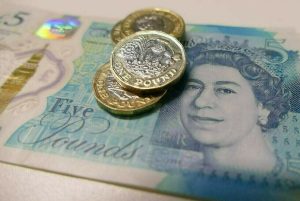US DOLLAR RETREATS AS INFLATION RUNS WARM, JOBLESS CLAIMS TICK HIGHER
The U.S. dollar weakened against major currencies such as the euro and yen on Thursday, as modestly hotter August inflation data and weaker-than-expected initial jobless claims reinforced the view that the Federal Reserve will resume cutting interest rates next week. In afternoon trading, the dollar was down 0.3% against the yen at 147.09 yen, while the euro rose 0.4% to $1.1738. As a result, the dollar index, a measure of the greenback’s value against six major currencies, dipped 0.3% to 97.51. The euro was also helped in part by diminished expectations of further cuts in borrowing costs, after the European Central Bank left interest rates unchanged on Thursday as expected and maintained an upbeat view on growth and inflation. U.S. economic data, however, was the more predominant currency driver. Data showed U.S. consumer prices rose more than expected in August while the annual increase in inflation was the largest in seven months. The Consumer Price Index increased 0.4% last month after increasing 0.2% in July, the Labor Department’s Bureau of Labor Statistics said. In the 12 months through August, the CPI advanced 2.9%, the largest increase since January, after climbing 2.7% in July. “The CPI didn’t come in as high as the market expected. Ultimately, the biggest concern … is that the dovishness that comes with the weak jobs numbers is going to be unwound if CPI accelerates more than expected,” said Eugene Epstein, head of trading and structured products, North America, at Moneycorp in New Jersey. “But that didn’t really materialize. Everybody would prefer CPI to be softer, but the point is, the data does not really change the course or move the needle for Fed rates.” More importantly, initial claims for state unemployment benefits jumped 27,000 to a seasonally adjusted 263,000 for the week ended September 6, data showed. Economists polled by Reuters had forecast 235,000 claims for the latest week. “For the first time in a long time, CPI is being overshadowed on its release day by another data series,” wrote Josh Jamner, senior investment strategy analyst at ClearBridge Investments in an email. He noted that the spike in initial jobless claims to the highest level in four years had helped briefly push the 10-year Treasury yield below 4%, despite the larger-than-expected increase in the consumer price index. “This dynamic illustrates the Fed’s focus on the ‘maximum employment’ half of the dual mandate, with today’s inflation print not hot enough in our view to derail a 25 basis point interest rate cut at next week’s FOMC meeting.” Attention on the labor market has intensified after two poor U.S. jobs reports over the last few days. The non-farm employment number for August showed just 22,000 jobs created compared with forecasts of 75,000, while payrolls were revised downwards by 911,000 for the year ending in March. Following Thursday’s data, fed funds futures are pricing in a 91% chance of a 25 bp cut this month and a 9% chance of a 50 bp decline, according to the CME’s FedWatch. That was unchanged from levels late on Wednesday. In other currency pairs, the euro gained 0.2% against the yen to 172.78 yen and was flat against sterling at 86.14 pence. ECB President Christine Lagarde told a press conference after the bank held interest rates steady at 2% that the euro zone continues to be in a “good place,” adding that inflation is where the ECB wanted it to be. The euro is stabilizing after a two-day streak of declines as geopolitical tensions continue on the EU’s eastern flank. Poland said it shot down suspected Russian drones in its airspace on Wednesday with the backing of aircraft from its NATO allies, the first time a member of the Western military alliance is known to have fired shots during Russia’s war in Ukraine. Elsewhere, the dollar fell 0.5% versus the Swiss franc to 0.7956, while sterling gained 0.4% versus the greenback to $1.3578. Also seemingly unnoticed was news that Stephen Miran moved closer to becoming a Fed governor, furthering U.S. President Donald Trump’s effort to exert more direct control over interest rate policy. The Senate Banking Committee voted to advance Miran’s nomination, though lawmakers involved said it is far from certain if the process can be completed in time for him to participate in the coming meeting.

STERLING SLIPS AS TRADERS AWAIT US INFLATION PRINT
The pound fell against a broadly stronger dollar on Thursday as markets focused on impending key U.S. inflation data and a European Central Bank policy meeting, as well as next week’s Federal Reserve and Bank of England meetings. Sterling was down 0.2% at $1.3505 at around 1000 GMT. The pound was 0.1% lower against the euro at 86.545. Sterling has come back from has a one-month low hit in early September after a sell-off in long-dated government bonds pushed yields to their highest since the late 1990s amid jitters over the UK’s public finances. It is part of a broader storm hitting the long-dated government debt of G7 major world economies. Pressure is mounting on finance minister Rachel Reeves to keep Britain’s deficit in check with the next budget announcement due at the end of November. “Rising government borrowing costs, in the form of higher yields on its bonds, or gilts, mean Rachel Reeves will want to put together a tax-and-spending plan that appeases bond vigilantes,” Russ Mould, AJ Bell investment director, said in a note. Reeves said on Thursday she would look at reforming business property taxes to make it easier for smaller firms to expand, as she seeks to boost growth. The Bank of England’s monetary policy committee convenes next Thursday to deliver its next rate decision. Money markets are betting it will hold rates steady at 4%. Elsewhere, British house prices in August experienced the most widespread falls in more than a year-and-a-half, a survey showed.
STOCKS RISE, DOLLAR FALLS AS SOFT US JOBS DATA FUELS RATE CUT BETS
MSCI’s global equities gauge hit a record high on Thursday while U.S. Treasury yields fell along with the dollar due to growing expectations for interest rate cuts, as softer labor market data overshadowed a higher-than-expected U.S. inflation reading. The Consumer Price Index increased by 0.4% in August, the most in seven months and following a 0.2% rise in July, driven by a 0.4% jump in housing costs and a 0.5% increase in food prices. The cost of food consumed at home jumped 0.6%. But in a separate report, the Labor Department said initial claims for state unemployment benefits jumped 27,000 to a seasonally adjusted 263,000 for the week ended September 6, which was the highest level since October 2021 and surpassed economist estimates for 235,000 claims. The higher-than-expected claims numbers solidified expectations that the Federal Reserve will cut U.S. interest rates next Wednesday and increased bets for more cuts in October and in December. “It feels like markets are focused on the softening labor market. That implies a Fed that is going to embark on a rate-cutting cycle,” said Mona Mahajan, head of investment strategy at Edward Jones. “After next week, they’ll be looking to see how both the inflation and labor market play out.” Traders were betting on a 100% probability for a rate cut at the Fed meeting next week with a roughly 5% chance for a super-sized half percentage point cut. Bets for another quarter percentage point cut in October rose to about 86% from Wednesday’s 74%, while the probability for a third cut in December rose to roughly 79% from 68%, according to the CME Group’s FedWatch, tool. “The focus shifted away from the CPI print to the jobless claim number. The claims number was a little bit higher than expected, so it is a potential indicator we’re seeing further weakness in the labor market,” said Jack Janasiewicz, lead portfolio strategist at Natixis Investment Managers Solutions. “What you’re getting is this tug of war between data that’s pointing to slowing in the economy, but at the same time the reaction is to price-in additional Fed easing, which is giving support to the market,” Janasiewicz added.

STERLING SLIPS AS ECONOMY STAGNATES, EYES ON BOE
The British pound dropped against the dollar on Friday after data showed the economy had stagnated in July, although it was still set for its second weekly rise before a Bank of England policy meeting next week. UK gross domestic product remained unchanged in July after growing 0.4% in June, the Office for National Statistics said, as manufacturing output, which makes up 9% of the economy, dropped by 1.3% on the month. “These GDP numbers are very volatile but the trend is a little bit softer over the last few months than it was earlier in the year,” said Dominic Bunning, head of G10 FX strategy at Nomura. “It’s a relatively volatile series that isn’t going to make the BoE concerned.” The pound was down 0.2% against the dollar at $1.3553, but was still set for a 0.3% weekly rise. The BoE is widely expected to keep its benchmark Bank Rate unchanged on September 18, after a split decision to lower the rate to 4% in August. Investors instead were focusing on the central bank’s plans to reduce its bond holdings, known as quantitative tightening, which are announced at the September meeting every year. The BoE has reduced its bond holdings by 100 billion pounds ($135.32 billion) over the past year and Governor Andrew Bailey said earlier this month that the future pace of QT was an “open decision”. A BoE survey of investors last month showed a median expectation that the central bank will slow the pace over the next 12 months to 72 billion pounds. A reduction to 75 billion is “unlikely to rock the boat,” ING analysts said in a research note. If the BoE were to keep the pace of bond sales unchanged, gilts could come under pressure, pushing yields higher, said Nomura’s Bunning. “Generally speaking, big moves higher in gilt yields, particularly long-end ones, are associated more with sterling weakness than with sterling strength,” Bunning said. “There is a bit of tail risk here for sterling.” Against the euro, the pound fell 0.1% to 86.51 pence but remained within its recent range.

US DOLLAR EDGES UP ON POSITIONING MOVES, BUT OUTLOOK STAYS NEGATIVE
The U.S. dollar drifted higher on Friday, a day after falling on a surge in U.S. jobless claims and a modest inflation uptick, ahead of a Federal Reserve meeting next week that is likely to cut interest rates after a roughly nine-month hiatus. The greenback rose 0.2% to 147.53 yen, rising for three straight weeks. The dollar firmed earlier on Friday after a U.S.-Japanese joint statement affirmed exchange rates should be “market determined” and that excess volatility and disorderly moves in exchange rates were undesirable. The dollar index was little changed at 97.59 but stayed on track to post a weekly fall of 0.1% for its second consecutive weekly decline. John Velis, Americas macro strategist at BNY in New York, said Friday’s gains were more about position-squaring ahead of the weekend. “The broader picture is still quite negative for the dollar on a variety of measures,” Velis said. “One, of course, is the Fed now beginning to cut rates. The other is, we still see hedging behavior taking place, so foreign investors buying U.S. assets and selling the dollar to hedge it, which is going to keep pressure on the dollar.” Data showing U.S. consumer sentiment falling for a second straight month in September weighed slightly on the greenback. The University of Michigan said on Friday its consumer sentiment index fell to 55.4 this month, the lowest since May, from a final reading of 58.2 in August. Economists polled by Reuters had been expecting a reading of 58.0, little changed from the month before. “If the Fed delivers the rate cut that is widely expected next week, and they signal that more rate cuts are coming, businesses may find optimism that they have an opportunity to recapture margin lost to tariffs, and consequently they can increase their capacity to increase headcount,” wrote Tom Simons, chief U.S. economist at Jefferies, in a email after the data. On Thursday, data showed the biggest weekly increase in four years in the number of Americans filing new applications for jobless benefits. That overshadowed U.S. consumer inflation data for August, which showed prices rising at the fastest pace in seven months but with increases still modest and broadly in line with expectations. While the mixed data might add some wrinkles to the Fed’s policy deliberations next week, investors are mostly focused on rate cut prospects. Pricing of Fed fund futures indicates that the market believes the Fed is certain to cut its key interest rate by 25 basis points (bps) on September 17. However, traders have reined in bets on a larger 50 bps rate cut next month, with pricing implying a shallower path of easing before the end of the year than anticipated earlier, according to the CME Group’s FedWatch tool. The benchmark 10-year Treasury note yield rose 4.9 bps to 4.06%. On Thursday, the yield fell below 4% for the first time since April. The euro was flat versus the dollar at $1.1736, a day after rising, as traders curbed their bets on another European Central Bank rate cut this cycle to bet on another move at less than 50%.
- CAPITALDIGEST MARKET REVIEW , 03/11/2025November 3, 2025
- CAPITALDIGEST DAILY NEWS, 03/11/2025November 3, 2025
- CAPITALDIGEST MARKET REVIEW, 22/09/2025September 22, 2025
Enter your email address for receiving valuable newsletters.
- CAPITALDIGEST DAILY NEWS, 03/11/2025NNPCL WEIGHS OVERHAUL, REPURPOSING OPTIONS FOR REFINERIES The Nigerian National Petroleum Company Limited has said...November 3, 2025
- CAPITALDIGEST MARKET REVIEW, 22/09/2025STERLING RISES AGAINST DOLLAR ON FED-BOE POLICY DIVERGENCE Sterling gained against the dollar on Tuesday,...September 22, 2025
- CAPITALDIGEST DAILY NEWS, 22/09/2025OIL REFORMS DRIVE $18.2BN DEALS – FG Nigeria’s oil and gas sector is experiencing a...September 22, 2025












